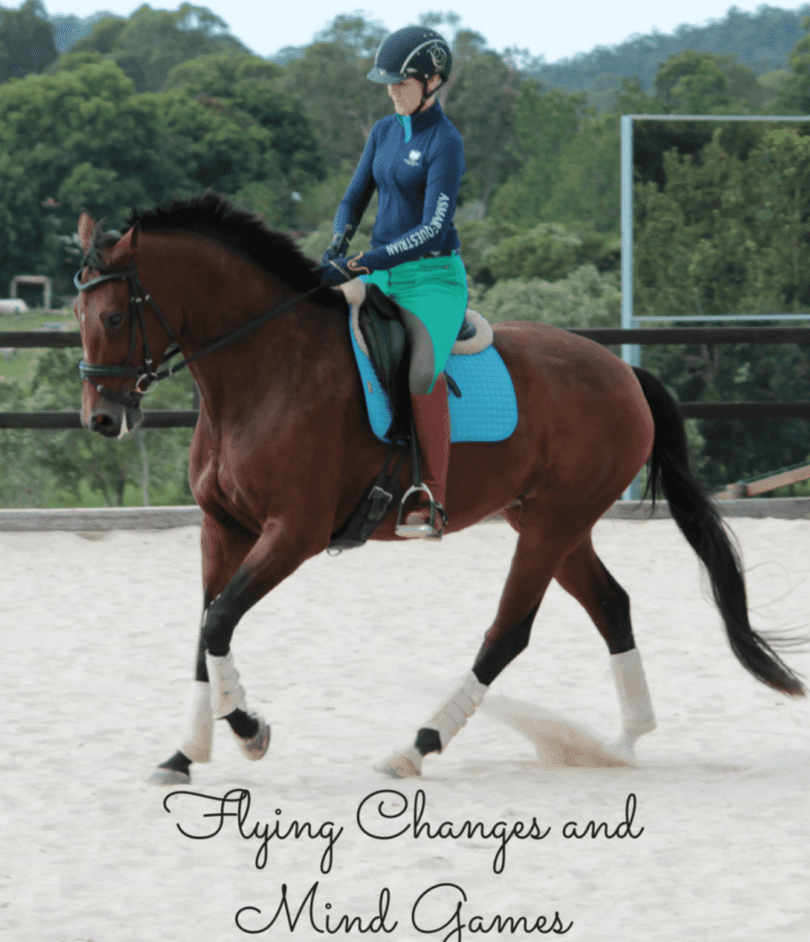Toward the end of last year, Nonie and I started work on the flying changes. Flying changes!!!
Being deemed ready to ride this brand new movement felt like a huge accomplishment. It felt like we had arrived! Having now started them, I can’t help but feel that my initial eagerness belied my naivety.
I have come to understand that the changes are a challenge which require strength, relaxation and timing. There is an additional layer of challenge because you either complete one or you don’t. Sure there are varying levels of excellence within this movement however learning to ride the changes is vastly different from other skills where you are able to gradually develop them.
For instance, when beginning shoulder-in you may feel a glimmer of brilliance before it slips through your fingers. You can then continue to build upon that feeling until suddenly you can ride a whole long side in shoulder-in.
The changes started well under the watchful and analytical eye of our coach Dani Keogh, but when we started to work on them on our own it was a different story. We would warm up well and progress on to school the flying changes.
After achieving maybe one or two each way that were fine, Nonie would brace against me, take over, and speed off. Maybe because she is an exuberant horse, or more likely this was the natural result of me asking with a far bigger aid than required.
So I would go home and read articles, watch videos and find a new exercise to try. I would try it a couple of times with success, but then Nonie would again take over.
The reason we were struggling with the flying changes wasn’t necessarily that my position is weak or because Nonie’s canter needed more jump and strength (although in some respects it does). Rather it was because whenever tension would enter in the canter work, particularly on the right rein Nonie would push in through her right shoulder allowing her to brace against me and avoid my aids.
Ironically this is the exact issue that Dani had spent a large chunk of time working on with us in our last lesson. Who’d have guessed!
It’s not the first time that I have learnt a lesson in this way where I’ve been told something a million times and then suddenly the lesson clicks and the light bulb goes off! Eureka, we have understanding!
I suspect a few factors play into this. I believe that timing is essential. In order to deeply understand a lesson, we must be in a place where mentally we are ready for it. On the other, it may have more to do with hearing the lesson explained in a way that makes sense. You know how 4+5 equals 9 but 3+6 also equals 9. Or maybe it’s a combination of all of these things.
So I took a few steps back to focus on the prerequisites for a good change. For example, the transitions, the balance, the tempo control and keeping her wrapped around my inside leg, and only occasionally asking for a change. This approach did help to create some progress.
Regardless, I sensed that my mind was also holding me back. This came more from past experiences of my mind getting in the way, rather than a true understanding of exactly what was happening at that point in time.
I suspected that a phone call to my performance and mindset coach, Danielle Pooles from Dressage Plus, would be helpful. So that was exactly what I did. I have sought Dani’s assistance previously with great success.
Anyone who has ridden
Talking through the difficulties I was having with Dani helped me to figure out exactly what was going on. For instance bracing against Nonie, holding tension in my thighs, and my mind going blank at the vital moment, I needed to ask for the change.
We then worked out a strategy, including breathing at key moments to help manage these issues. I got to try the strategy out the very next day. Low and behold, I was excited about the prospect of riding the changes rather than being nervous about how she would respond.
We only got a quick ride in due to me leaving work late. In spite of that, we managed a calm, easy change on each rein. No speeding up into the change. No barreling down into the reins after the change. No more excessive use of aids.
The flying changes are not yet perfect, but they are certainly improving and at the end of the day that’s all you can ask for. Little improvements each day add up to big changes in the long term (pardon the pun). This experience has reinforced for me the importance of mindset. Riding is as much a mind game as it is an athletic pursuit.
Until next time, happy riding!
P.S. Enjoy this article? Trot on over to:
- Write Your Own Letter to My Rookie Self
- Media Guide: Young Black Equestrians Podcast
- Braided: A Herd Dynamic (Horse Rookie Diversity Initiative)
- Letter to My Rookie Self: Emily Harris
- Letter to My Rookie Self: Sarah Harris
- Small Business Spotlight: The Positive Equestrian
